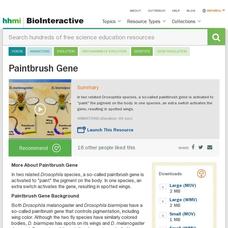Nature League
Why Are Animals Getting Smaller? - From A to B
Many believe dinosaurs were much larger than animals of today, but even the biggest dinosaur was only half the size of the average adult blue whale. Understanding why animals appear to be getting smaller starts with a discussion of...
Nature League
Adaptations at Animal Wonders - Field Trip
The word camouflage was first found use in English in the 1917 edition of Popular Science magazine. Camouflage, along with many other variations, star in the second video in a four-part series about adaptations. Join the virtual...
Veritasium
Is Our Food Becoming Less Nutritious?
Is today's food less nutritious? Veritasium explores the research and the reasons some scientists now consider food nutrient-deficient. The video also considers possible causes and whether the human population should be concerned.
Veritasium
Amazing Molecular Machines in Your Body
More than 50 billion cells in your body die every single day. While this sounds traumatic, the human body continuously produces new cells to replace them. A short video shares animations of the process of cell division or mitosis and...
Veritasium
Neutron Star Merger Gravitational Waves and Gamma Rays
Scientists have theorized about the merging of stars based on scientific theories and mathematical principles. For the first time, observation has confirmed these theories. Viewers share in the excitement of the discovery as they watch...
Nature League
Exploring Evolution and Speciation - Lesson Plan
The first video in a five-part series on Evolution and Speciation introduces four types of evolution and addresses common misconceptions. In addition, viewers learn about topics current understanding of science does not fully explain.
Crash Course
Genetics - Lost and Found: Crash Course History of Science #25
Gregor Mendel, known as the father of genetics, never knew genetics existed and, in fact, died thinking no one would recognize his scientific discoveries. Other genetics scientists, such as Barbara McClintock, performed work so far ahead...
Howard Hughes Medical Institute
Paintbrush Gene
Drosophila includes more than 1,500 species and often find themselves studied by geneticists. A scientist presents a lecture on one example of these studies on the paintbrush gene. The gene determines the amount and color of pigment on...
Howard Hughes Medical Institute
Pocket Mouse and Predation
The rock pocket mouse exists either with light colored or dark colored fur. As their habitat changes from sandy desert to lava flows the prominence of each color fur also changes. Viewers compare the visibility of each mouse's fur color...
Howard Hughes Medical Institute
Leptin Feedback Control System
Hormones come from many parts of the body, including the hormone leptin produced by fat tissues. This in turn, controls each person's hunger levels. Interested nutritionists view the feedback loop relating food intake, hormone levels,...
Howard Hughes Medical Institute
Triplet Code
Genetic code for amino acids always uses three letters. The explanation for why it occurs in triplets makes for a brief statistical video. Examples of single and double letter codes prove insufficient for the number of amino acids.
Howard Hughes Medical Institute
PPAR-gamma Activation in the Fat Cell
Each human contains more than six times the number of fat cells than there are people on the planet. Scholars learn how fat cells work to absorb fat and release hormones through a short animation. They recognize the relationship between...
Howard Hughes Medical Institute
DNA Transcription (Advanced Detail)
Transcription happens in every cell, including plants, animals, and in all living matter. Observe the process of transcription through a slow and detailed animation of the process. With each step described in detail, viewers comprehend...
Nature League
Nature + Philosophy
Scientists often define their underlying assumptions, but not always from a philosophical approach. Viewers learn about the philosophy of science from three experts in various fields. They discuss how the perception of science changes as...
Nature League
Can Complex Life Evolve Without Oxygen? - From A to B
Can complex life develop in an oxygen-depleted environment? Scholars listen to a discussion of the topic between two people: one interested in science without studying it and one working on a doctoral degree in science. The fourth video...
Nature League
Investigating Metabolism of Early Life - De-Natured
Even the titles of many published scientific journal articles confuse most people. The third video in the four-part series breaks down a very complex-sounding scientific journal article. The host avoids using jargon without losing the...
Nature League
What Is Life? - Lesson Plan
The first lesson in the five-part What is Life? series addresses the definition of life. It discusses characteristics, why the concept of carbon-based life is important, and the macro-molecules of life on Earth.
Veritasium
The Invention of Nuclear Weapons
Neutrons have approximately the same mass as a proton, but contain no charge. Something so seemingly insignificant changed the world thanks to nuclear weapons, nuclear energy, and nuclear radiation. Viewers learn more about the invention...
Veritasium
The Threat of AI Weapons
Will artificial intelligence weapons change the terms of war? As part of a larger playlist, a video about the future of AI weapons opens up the topic for discussion.
Nature League
Biodiversity and Extinction Vulnerability - De-Natured
Science benefits everyone, so why is the language in journal articles so difficult to understand? The third video in the four-part series on Biodiversity breaks down a journal article so everyone understands the content. The article...
Nature League
Everyday Biodiversity - Field Trip
Many pupils associate biodiversity with the rain forest or coral reefs, but there is so much more to learn. Join a virtual field trip into a pharmacy to explore the importance of biodiversity in all forms. The second video in a four-part...
Nature League
Increasing Night Life of Mammals - De-Natured
How do animals avoid predators, including humans, if they can't move to a new habitat? The third video in a four-part series explains a recently published article on the topic of adaptations. Many mammals shift their schedules to a more...
Nature League
What Are Adaptations? - Lesson Plan
Texas short-horned lizards shoot blood out of their eyes to deter predators. The unique adaption allows them to thrive in a hostile environment. Pupils learn more about this and other adaptations of plants, animals, and humans in the...
Veritasium
Can You Overdose on Vitamins?
Scholars learn how a vitamin deficiency causes blindness and death, while an overdose of the same vitamin also leads to death. Veritasium travels the world to research the role of vitamins in our lives, the best advice for taking or...























